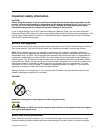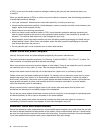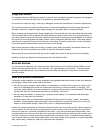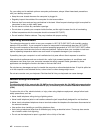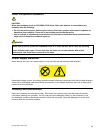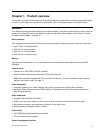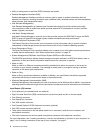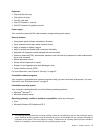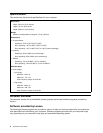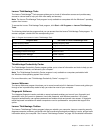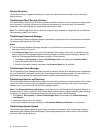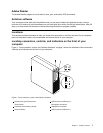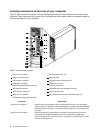
• Ability to store power-on self-test (POST) hardware test results
• Desktop Management Interface (DMI)
Desktop Management Interface provides a common path for users to access information about all
aspects of a computer, including processor type, installation date, attached printers and other peripherals,
power sources, and maintenance history.
• Intel Standard Manageability
Intel Standard Manageability is hardware and rmware technology that builds certain functionality
into computers in order to make them easier and less expensive for businesses to monitor, maintain,
update, upgrade, and repair.
• Intel Matrix Storage Manager
Intel Matrix Storage Manager is a device driver that provides support for SATA RAID 5 arrays and SATA
RAID 10 arrays on specic Intel chipset system boards to enhance hard disk performance.
• Preboot Execution Environment (PXE)
The Preboot Execution Environment is an environment to start computers using a network interface
independent of data storage devices (such as the hard disk drive) or installed operating systems.
• Smart Performance Choice
The Smart Performance Choice function enables your computer to run with better acoustic performance
or better thermal performance. See “Smart performance choices” on page 79.
• System Management (SM) Basic Input/Output System (BIOS) and SM software
The SM BIOS specication denes data structures and access methods in a BIOS that allows a user or
application to store and retrieve information specic about the computer in question.
• Wake on LAN
Wake on LAN is an Ethernet computer networking standard that allows a computer to be turned on
or woken up by a network message. The message is usually sent by a program running on another
computer on the same local area network.
• Wake on Ring
Wake on Ring, sometimes referred to as Wake on Modem, is a specication that allows supported
computers and devices to resume from sleep or hibernation mode.
• Windows Management Instrumentation (WMI)
Windows Management Instrumentation is a set of extensions to the Windows Driver Model. It provides an
operating system interface through which instrumented components provide information and notication.
Input/Output (I/O) features
• 9-pin serial port (one standard and one optional)
• Eight Universal Serial Bus (USB) connectors (two on the front panel and six on the rear panel)
• One Ethernet connector
• One DisplayPort connector
• One VGA monitor connector
• One Personal System/2 (PS/2) keyboard connector (optional)
• One PS/2 mouse connector (optional)
• Three audio connectors on the rear panel (audio line-in connector, audio line-out connector, and
microphone connector)
• Two audio connectors on the front panel (microphone connector and headphone connector)
For more information, see “Locating connectors, controls, and indicators on the front of your computer” on
page 7
and “Locating connectors on the rear of your computer” on page 8.
2 ThinkCentre User Guide




